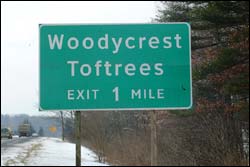New easy-read road signs based on PSU research

Example of a sign near Penn State that uses the new Clearview road sign typeface based on University research. Credit: Penn State, Greg Grieco
New easier-to-read road signs based on Penn State research are appearing across the U.S. and Canada.
The Federal Highway Administration (FHWA) has approved the interim use of a new typeface, called Clearview, for signs on all public streets, highways, and byways. New signs bearing Clearview, instead of the old familiar Highway Gothic, already appear on Routes 322 and 80 in Pennsylvania near Penn State, on highways throughout Texas and in Canada.
A decade in development, the Clearview Typeface System for traffic control devices was developed by a design team that included Dr. Martin Pietrucha, a civil engineer and director of the University’s Science, Technology and Society program, and Philip Garvey, research associate at Penn State’s Pennsylvania Transportation Institute.
The new Clearview road sign typeface is so much more legible than the existing typeface that it gives drivers going 55 mph added seconds to respond to directions.
Clearview offers a 20 percent improvement in legibility and recognition with the same size sign as currently used. Replacing signs bearing the 50-year-old Standard Highway Sign Alphabet with new Clearview signs should not cause driver confusion or increase costs, the two Penn State researchers say.
An interdisciplinary team including perceptual psychologists, traffic engineers, type designers, graphic designers, vision experts and optics engineers developed Clearview. Their goal was to improve road sign legibility and recognition at night, especially for older drivers.
Pietrucha says, “Clearview achieves its greater legibility by using upper and lower case with initial capital letters, special spacing based on how a viewer reads a legend from an extended distance and by eliminating nighttime overglow or halo-ing.”
He explains that overglow occurs when a car’s headlights shine directly on a sign on which letters have been formed from highly reflective material. The letters become, momentarily, so bright that they lose their familiar shape and look instead like blobs. Overglow is especially troublesome for those over age 65.
Clearview retains its readability, despite overglow, because the letters have been designed to have more interior space. The B, e, g and a, for example, have more space inside the letters so that when halo-ing occurs, the overglow doesn’t entirely fill them up.
Garvey notes that Clearview’s design is based on the results of six formal studies and dozens of field reviews using younger drivers as well as older ones in both day and night driving conditions.
“Inadequate signing can be a contributing factor in roadway crashes,” he adds. “Although Clearview was intended to help older drivers, our studies show that the appreciable gain in reaction time provided by the new typeface will be achieved by drivers regardless of age.”
The Clearview Typeface system for traffic control devices was developed by a design team that included Donald Meeker and Christopher O’Hara of Meeker & Associates Inc., James Montalbano of Terminal Design Inc., and Pietrucha and Garvey, with supporting research by Dr. Gene Hawkins and Dr. Paul Carlson of the Texas Transportation Institute (TTI) sponsored by TxDOT. Susan T. Chrysler of TTI provided consultation on experimental design.
Media Contact
More Information:
http://www.psu.eduAll latest news from the category: Transportation and Logistics
This field deals with all spatial and time-related activities involved in bridging the gap between goods and people, including their restructuring. This begins with the supplier and follows each stage of the operational value chain to product delivery and concludes with product disposal and recycling.
innovations-report provides informative reports and articles on such topics as traffic telematics, toll collection, traffic management systems, route planning, high-speed rail (Transrapid), traffic infrastructures, air safety, transport technologies, transport logistics, production logistics and mobility.
Newest articles

Zap Energy achieves 37-million-degree temperatures in a compact device
New publication reports record electron temperatures for a small-scale, sheared-flow-stabilized Z-pinch fusion device. In the nine decades since humans first produced fusion reactions, only a few fusion technologies have demonstrated…

Innovative microscopy demystifies metabolism of Alzheimer’s
Researchers at UC San Diego have deployed state-of-the art imaging techniques to discover the metabolism driving Alzheimer’s disease; results suggest new treatment strategies. Alzheimer’s disease causes significant problems with memory,…

A cause of immunodeficiency identified
After stroke and heart attack: Every year, between 250,000 and 300,000 people in Germany suffer from a stroke or heart attack. These patients suffer immune disturbances and are very frequently…





















